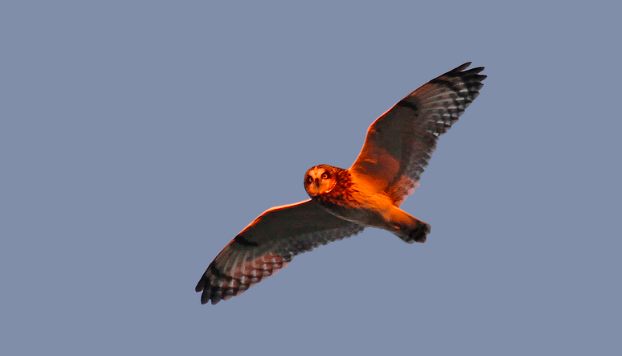
Short-eared Owl, Ryan Schain
Continental Summary
Light to moderate flights in the West last weekend featured Bufflehead, Cackling Goose, Ring-necked Duck, Herring Gull, Varied Thrush, Ruby-crowned Kinglet, Golden-crowned Sparrow, and Dark-eyed Junco, while several pulses of moderate to very heavy flights in the East featured Green-winged Teal, Bufflehead, Northern Harrier, Wilson’s Snipe, Hermit Thrush, Eastern Meadowlark, Snow Bunting, White-throated Sparrow, Swamp Sparrow, Le Conte’s Sparrow, and Field Sparrow.
Curious what birds will move next? Check out our forecast.
Need a review of our definitions for regions, species on the move, and migration amounts? Please visit this link.
Quick Links to Regions
Upper Midwest and Northeast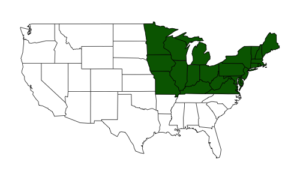 |
Gulf Coast and Southeast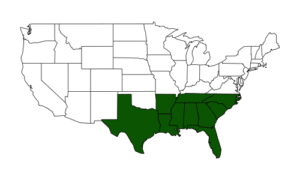 |
Great Plains |
West |
Upper Midwest and Northeast
Northerly flow and slightly cooler temperatures following the passage of a cold front brought moderate to very heavy flights to the Midwest and Northeast on Friday and Saturday nights. Following the passage of this front, high pressure returned to the region and quieted the movements substantially by Sunday night. Another frontal passage through the region brought moderate to heavy flights in the Midwest and mid Atlantic on Monday and Tuesday nights, with the extent of these flights reaching the coast by Wednesday night. Note that some coastal movements on Wednesday night were very heavy, particular in New Jersey and DelMarVa. Another disturbance moving through the eastern Great Lakes on Thursday night spawned a new round of moderate to heavy flights, as the remainder of the region farther east saw little movement in primarily unfavorable southerly flow. Note that some localized flights occurred in the mid Atlantic, where conditions were locally favorable for the large number of migrants from previous nights’ to take flight.
Top Movers
Increasing
| Species | Increase from Last Week | % of Checklists Reporting |
|---|---|---|
| Ruddy Duck | 73% | 5.5 |
| American Coot | 44% | 6 |
| American Tree Sparrow | 118% | 1.2 |
| Dark-eyed Junco | 23% | 16.5 |
| Franklin's Gull | 84% | 1.2 |
| Lesser Scaup | 57% | 1.5 |
| Redhead | 63% | 2.1 |
| Fox Sparrow | 41% | 2.1 |
| Bufflehead | 231% | 0.5 |
| Field Sparrow | 17% | 8.8 |
| Gadwall | 29% | 3.2 |
| Hermit Thrush | 16% | 8.5 |
| Ring-necked Duck | 31% | 2.3 |
| Pied-billed Grebe | 17% | 8.9 |
| Red-necked Grebe | 71% | 0.7 |
| Western Kingbird | 135% | 0.2 |
| Canvasback | 122% | 0.4 |
| Red-winged Blackbird | 8% | 24.8 |
| White-throated Sparrow | 8% | 33.2 |
| American Wigeon | 19% | 3.8 |
| Snow Bunting | 366% | 0.1 |
| Wilson's Snipe | 16% | 2.7 |
| Northern Harrier | 14% | 6.6 |
| Green-winged Teal | 13% | 7.1 |
| Short-eared Owl | 158% | 0.1 |
Decreasing
| Species | Decrease from Last Week | % of Checklists Reporting |
|---|---|---|
| Chimney Swift | -64% | 3.8 |
| American Redstart | -77% | 0.8 |
| Black-throated Green Warbler | -62% | 2.3 |
| Eastern Wood-Pewee | -80% | 0.6 |
| Black-and-white Warbler | -78% | 0.6 |
| Magnolia Warbler | -67% | 1.1 |
| Tennessee Warbler | -60% | 1.6 |
| Common Yellowthroat | -50% | 7.1 |
| Scarlet Tanager | -83% | 0.2 |
| Gray Catbird | -40% | 16.3 |
| Black-throated Blue Warbler | -55% | 2.2 |
| Swainson's Thrush | -55% | 1.6 |
| Rose-breasted Grosbeak | -71% | 0.5 |
| Ruby-throated Hummingbird | -76% | 0.5 |
| House Wren | -47% | 3.6 |
| Northern Parula | -55% | 1.7 |
| Indigo Bunting | -48% | 3 |
| Gray-cheeked Thrush | -76% | 0.2 |
| Wood Thrush | -90% | 0.1 |
| Eastern Phoebe | -29% | 17.9 |
| Nashville Warbler | -41% | 2.8 |
| Red-eyed Vireo | -61% | 1.3 |
| Cape May Warbler | -64% | 0.7 |
| Yellow-bellied Sapsucker | -36% | 6.9 |
| Northern Rough-winged Swallow | -52% | 0.8 |
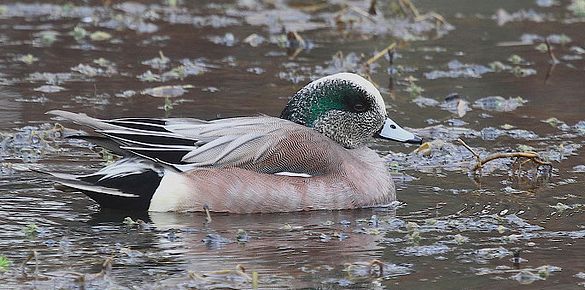
American Wigeon, Ryan Schain
Gulf Coast and Southeast
Moderate to very heavy flights occurred across the region during the period. These movements occurred in several waves, but much of the region participate in the action and experienced excellent migration nights. The pulses of favorable conditions moved in two to three waves through the southeast, alternating with locally unfavorable conditions where migration was minimal. By the end of the period, movements were increasingly restricted to coastal areas from the Carolinas into Florida and west along the Gulf Coast through Texas.
Top Movers
Increasing
| Species | Increase from Last Week | % of Checklists Reporting |
|---|---|---|
| White-throated Sparrow | 339% | 4 |
| Swamp Sparrow | 309% | 5.2 |
| Yellow-rumped Warbler | 134% | 8.5 |
| American Coot | 68% | 10.3 |
| Lincoln's Sparrow | 95% | 5 |
| Savannah Sparrow | 89% | 5.2 |
| Yellow-bellied Sapsucker | 45% | 10.3 |
| Ruby-crowned Kinglet | 48% | 14.9 |
| Palm Warbler | 38% | 21.5 |
| Eastern Phoebe | 37% | 32.3 |
| Song Sparrow | 44% | 8 |
| White-crowned Sparrow | 287% | 1.3 |
| American Wigeon | 181% | 1.5 |
| Pied-billed Grebe | 39% | 16.1 |
| House Wren | 37% | 10.5 |
| Golden-crowned Kinglet | 89% | 2 |
| Greater White-fronted Goose | 1949% | 0.7 |
| Chipping Sparrow | 47% | 6.6 |
| Eastern Meadowlark | 65% | 4.7 |
| Northern Flicker | 18% | 24.9 |
| Blue-headed Vireo | 53% | 3.6 |
| Gadwall | 163% | 1 |
| Vesper Sparrow | 178% | 0.7 |
| Redhead | 150% | 1 |
Decreasing
| Species | Decrease from Last Week | % of Checklists Reporting |
|---|---|---|
| Philadelphia Vireo | -74% | 0.2 |
| Chimney Swift | -29% | 7.8 |
| Wilson's Warbler | -52% | 0.9 |
| Golden-winged Warbler | -75% | 0.1 |
| Veery | -55% | 0.5 |
| Chestnut-sided Warbler | -43% | 1.9 |
| Eastern Kingbird | -82% | 0.1 |
| Yellow Warbler | -36% | 1.8 |
| Broad-winged Hawk | -32% | 1.5 |
| Ruby-throated Hummingbird | -21% | 11 |
| Roseate Spoonbill | -22% | 3.5 |
| Bobolink | -48% | 0.8 |
| Cattle Egret | -16% | 6.4 |
| Cliff Swallow | -41% | 0.4 |
| Mississippi Kite | -88% | 0 |
| Wood Thrush | -29% | 2.4 |
| Burrowing Owl | -73% | 0 |
| Bell's Vireo | -73% | 0 |
| Rose-breasted Grosbeak | -25% | 4.3 |
| Least Flycatcher | -53% | 0.2 |
| Common Raven | -27% | 1 |
| Northern Waterthrush | -24% | 1.8 |
| Yellow-breasted Chat | -51% | 0.2 |
| Green Heron | -18% | 5.1 |
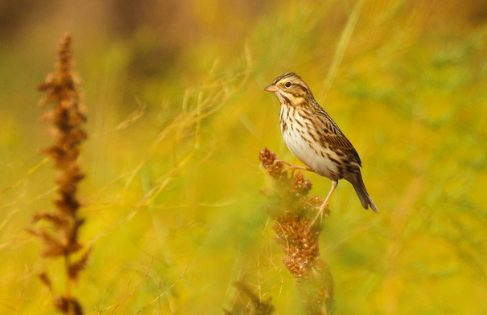
Savannah Sparrow, Ryan Schain
Great Plains
No extensive intense flights occurred at the regional scale during this period. However, northern, central, and southern Plains’ locations each experienced pulses of moderate flights. The most extensive occurred in the southern Plains to kick off last weekend, followed on Sunday night by similarly intense flights in the central Plains. Monday night saw the most extensive of the region’s flight for the week, with light to moderate flights in the north and moderate flights in the central and southern Plains. As similarly extensive but less intense movement ended the period on Thursday night.
Top Movers
Increasing
| Species | Increase from Last Week | % of Checklists Reporting |
|---|---|---|
| Le Conte's Sparrow | 164% | 9.2 |
| Nelson's Sparrow | 308% | 5.2 |
| Song Sparrow | 111% | 23.4 |
| Harris's Sparrow | 59% | 12 |
| Savannah Sparrow | 48% | 18.1 |
| Bonaparte's Gull | 501% | 2 |
| Ring-necked Duck | 397% | 3.1 |
| Horned Grebe | 359% | 3 |
| Redhead | 98% | 6.6 |
| Northern Pintail | 72% | 7.9 |
| American Wigeon | 82% | 5.8 |
| Swamp Sparrow | 47% | 9.6 |
| Pine Siskin | 57% | 7.3 |
| Dark-eyed Junco | 30% | 22.4 |
| Sandhill Crane | 94% | 2.1 |
| White-crowned Sparrow | 35% | 13.2 |
| Franklin's Gull | 31% | 24 |
| Field Sparrow | 43% | 9.4 |
| American Coot | 26% | 22.6 |
| Ring-billed Gull | 32% | 18.3 |
| Western Meadowlark | 31% | 13.6 |
| Eastern Meadowlark | 28% | 14.1 |
| Northern Saw-whet Owl | 134% | 0.8 |
Decreasing
| Species | Decrease from Last Week | % of Checklists Reporting |
|---|---|---|
| Peregrine Falcon | -100% | 0 |
| Summer Tanager | -97% | 0 |
| Indigo Bunting | -81% | 0.7 |
| Ruby-throated Hummingbird | -96% | 0.1 |
| Snowy Egret | -79% | 0.9 |
| Chimney Swift | -65% | 3.1 |
| Nashville Warbler | -59% | 4.1 |
| Gray Catbird | -61% | 2.7 |
| Broad-winged Hawk | -100% | 0 |
| Purple Finch | -75% | 0.5 |
| Rose-breasted Grosbeak | -95% | 0 |
| Blue-headed Vireo | -57% | 1.2 |
| American Bittern | -83% | 0.2 |
| Spotted Sandpiper | -95% | 0 |
| Brown Thrasher | -35% | 4.5 |
| Hairy Woodpecker | -27% | 9 |
| Barn Swallow | -35% | 5.8 |
| Tennessee Warbler | -54% | 1.1 |
| Eastern Phoebe | -21% | 13.2 |
| House Wren | -26% | 7.2 |
| Common Nighthawk | -47% | 1.3 |
| Cedar Waxwing | -22% | 7 |
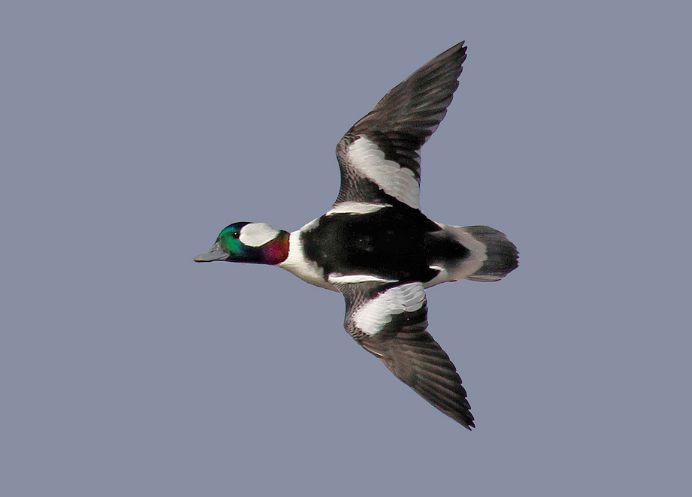
Bufflehead, Ryan Schain
West
Light to moderate flights were scattered across the west last weekend. Additionally, a local flight in the Pacific Northwest on Tuesday night that reached moderate to locally heavy intensities was a bright spot in what was otherwise a mostly quiet remainder of the period across the region. Note that some areas of the southern Rockies saw more intense flights, in some places moderate to locally heavy, particularly last weekend and to end the period on Thursday night.
Top Movers
Increasing
| Species | Increase from Last Week | % of Checklists Reporting |
|---|---|---|
| Bufflehead | 108% | 1.7 |
| Hermit Thrush | 25% | 7.8 |
| Ruby-crowned Kinglet | 13% | 25.4 |
| Dark-eyed Junco | 16% | 30.1 |
| Golden-crowned Sparrow | 21% | 18 |
| American Crow | 15% | 34.3 |
| Varied Thrush | 68% | 3.1 |
| Herring Gull | 21% | 2.8 |
| Ring-necked Duck | 15% | 5.1 |
| Thayer's Gull | 61% | 0.5 |
| American Tree Sparrow | 80% | 0.3 |
| Cackling Goose | 15% | 3.7 |
| American Wigeon | 9% | 9.8 |
| White-throated Sparrow | 16% | 1.6 |
| American Pipit | 14% | 6.1 |
| Northern Mockingbird | 7% | 12.9 |
Decreasing
| Species | Decrease from Last Week | % of Checklists Reporting |
|---|---|---|
| Warbling Vireo | -83% | 0.3 |
| Vaux's Swift | -75% | 0.2 |
| Western Wood-Pewee | -81% | 0.2 |
| Black-throated Gray Warbler | -48% | 2.7 |
| Wilson's Warbler | -57% | 1.6 |
| Yellow Warbler | -44% | 2.9 |
| Violet-green Swallow | -63% | 0.5 |
| Western Tanager | -62% | 0.7 |
| Franklin's Gull | -62% | 0.4 |
| Swainson's Hawk | -50% | 0.5 |
| Sabine's Gull | -65% | 0.2 |
| Barn Swallow | -48% | 2.7 |
| Common Tern | -65% | 0.2 |
| Swainson's Thrush | -62% | 0.3 |
| Summer Tanager | -59% | 0.2 |
| Red-necked Phalarope | -67% | 0.3 |
| Orange-crowned Warbler | -27% | 8.8 |
| Pacific-slope Flycatcher | -44% | 0.7 |
| Black-chinned Hummingbird | -62% | 0.3 |
| Turkey Vulture | -22% | 12.2 |
| Vesper Sparrow | -36% | 1.2 |
| Pectoral Sandpiper | -64% | 0.1 |
–––––––––––––––––––––––––––––––––––
Farnsworth and Van Doren




